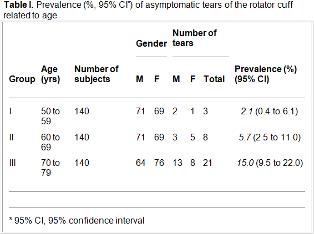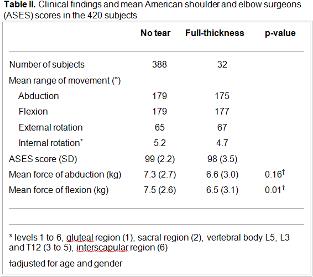Prevalence and characteristics of asymptomatic tears of the rotator cuff: an ultrasonographic and clinical study.
Authors: Moosmayer S, Smith HJ, Tariq R, Larmo A.
References: J Bone Joint Surg Br. 2009 Feb;91(2):196-200.
We undertook clinical and ultrasonographic examination of the shoulders of 420 asymptomatic volunteers aged between 50 and 79 years. MRI was performed in selected cases.
Full-thickness tears of the rotator cuff were detected in 32 subjects (7.6%). The prevalence increased with age as follows:
50 to 59 years, 2.1%;
60 to 69 years, 5.7%; and
70 to 79 years, 15%.
The mean size of the tear was less than 3 cm and tear localisation was limited to the supraspinatus tendon in most cases (78%). The strength of flexion was reduced significantly in the group with tears (p = 0.01).
Asymptomatic tears of the rotator cuff should be regarded as part of the normal ageing process in the elderly but may be less common than hitherto believed.


Comment from Pocellini:
This paper addresses an important issue: subjects with an asymptomatic lesion have impaired rotator cuff function and are more prone to developing symptomatic tears even with minor trauma. When a pain-free lesion is detected surgery is not required, but both surgeon and patient can be more confident that progression of the tear or the development of cuff-related degenerative changes can be slowed down by maintaining rotator cuff balance through physiotherapy.


